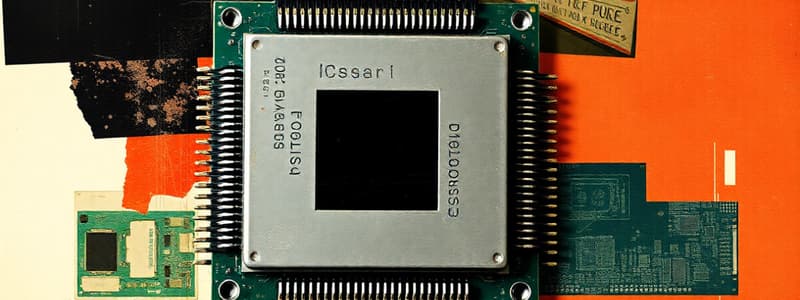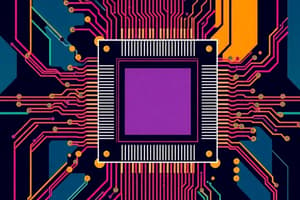Podcast
Questions and Answers
Explain the role of the control unit within the CPU during the fetch-decode-execute cycle.
Explain the role of the control unit within the CPU during the fetch-decode-execute cycle.
The control unit manages and synchronizes the actions of other CPU components during each step of the cycle. It decodes instructions and sends signals to the ALU, registers, and memory, orchestrating the overall process.
What is the significance of the address bus in the context of data retrieval from RAM?
What is the significance of the address bus in the context of data retrieval from RAM?
The address bus specifies the unique memory location (memory address) from which the CPU needs to retrieve data, ensuring the correct data is accessed.
Describe how cache memory improves overall CPU performance.
Describe how cache memory improves overall CPU performance.
Cache memory stores frequently used data and instructions, allowing the CPU to access them faster than accessing RAM. This reduces the time the CPU spends waiting for data, thus boosting performance.
How do multicore processors enhance a computer's ability to perform multitasking?
How do multicore processors enhance a computer's ability to perform multitasking?
Explain what a 'bottleneck' is in the context of computer performance, and give an example involving the CPU.
Explain what a 'bottleneck' is in the context of computer performance, and give an example involving the CPU.
What is the primary difference between RAM and ROM in terms of data storage?
What is the primary difference between RAM and ROM in terms of data storage?
Describe the function of the arithmetic logic unit (ALU).
Describe the function of the arithmetic logic unit (ALU).
Explain how virtual memory works and why excessive use of it can lead to 'disk thrashing'.
Explain how virtual memory works and why excessive use of it can lead to 'disk thrashing'.
What role do registers play in the CPU, and why are they important?
What role do registers play in the CPU, and why are they important?
Explain the relationship between clock speed and CPU performance, and why is clock speed not the only factor determining CPU performance?
Explain the relationship between clock speed and CPU performance, and why is clock speed not the only factor determining CPU performance?
Describe the roles of the data bus and the control bus in the transfer of information between the CPU and memory.
Describe the roles of the data bus and the control bus in the transfer of information between the CPU and memory.
Explain the purpose of Level 1 (L1) cache and where it is typically located in a modern CPU.
Explain the purpose of Level 1 (L1) cache and where it is typically located in a modern CPU.
What are the advantages of using a multicore processor compared to a single-core processor when running multiple applications simultaneously?
What are the advantages of using a multicore processor compared to a single-core processor when running multiple applications simultaneously?
How does the 'fetch' stage of the fetch-decode-execute cycle work?
How does the 'fetch' stage of the fetch-decode-execute cycle work?
Describe the difference between reading and writing data in relation to RAM.
Describe the difference between reading and writing data in relation to RAM.
Explain what firmware is and where it is typically stored in a computer system.
Explain what firmware is and where it is typically stored in a computer system.
How does bus width affect the amount of data that can be transmitted at once?
How does bus width affect the amount of data that can be transmitted at once?
What are the potential drawbacks of increasing the clock speed of a CPU to enhance performance?
What are the potential drawbacks of increasing the clock speed of a CPU to enhance performance?
Explain the role of the electronic clock in the CPU.
Explain the role of the electronic clock in the CPU.
How does the use of cache memory address the bottleneck caused by slower RAM speeds relative to CPU processing speeds?
How does the use of cache memory address the bottleneck caused by slower RAM speeds relative to CPU processing speeds?
Flashcards
CPU (Central Processing Unit)
CPU (Central Processing Unit)
The hardware device in a computer that carries out the processing of instructions.
RAM (Random-Access Memory)
RAM (Random-Access Memory)
Temporary storage for data and instructions that the CPU actively uses.
Bus (in Computer Architecture)
Bus (in Computer Architecture)
A set of wires connecting the CPU to memory and I/O devices.
Fetch-Decode-Execute Cycle
Fetch-Decode-Execute Cycle
Signup and view all the flashcards
ALU (Arithmetic Logic Unit)
ALU (Arithmetic Logic Unit)
Signup and view all the flashcards
Registers (in CPU)
Registers (in CPU)
Signup and view all the flashcards
Control Unit
Control Unit
Signup and view all the flashcards
Clock (CPU)
Clock (CPU)
Signup and view all the flashcards
Clock Speed
Clock Speed
Signup and view all the flashcards
Address Bus
Address Bus
Signup and view all the flashcards
Data Bus
Data Bus
Signup and view all the flashcards
Control Bus
Control Bus
Signup and view all the flashcards
Bus Width
Bus Width
Signup and view all the flashcards
Writing (to Memory)
Writing (to Memory)
Signup and view all the flashcards
Reading (from Memory)
Reading (from Memory)
Signup and view all the flashcards
Cache Memory
Cache Memory
Signup and view all the flashcards
Multicore Processors
Multicore Processors
Signup and view all the flashcards
Bottleneck (in Computing)
Bottleneck (in Computing)
Signup and view all the flashcards
ROM (Read-Only Memory)
ROM (Read-Only Memory)
Signup and view all the flashcards
Virtual Memory
Virtual Memory
Signup and view all the flashcards
Study Notes
- The central processing unit (CPU) is the hardware device in a computer responsible for processing.
- CPUs in Von Neumann architecture connect to memory (RAM) and I/O devices via a bus.
- When a computer starts, the CPU fetches instructions from main memory, executes them, and repeats until powered off.
Fetch-Decode-Execute Cycle
- The CPU fetches an instruction from memory using the address bus and control bus.
- The control unit decodes the instruction and signals other CPU parts on what to do.
- The CPU then executes the instruction completing the function.
Key CPU Components
- The arithmetic/logic unit (ALU) performs calculations and logic operations.
- Registers are very fast memory locations inside the CPU which hold instructions, addresses, or data.
- The control unit organizes actions of the CPU components.
- An electronic clock synchronizes the cycle, with clock speed (GHz) indicating cycles per second, thus faster processing.
- Faster clock speeds increase heat production and power consumption.
Bus System
- The bus connects the CPU to other devices using address, data, and control buses.
- The address bus carries memory addresses.
- The data bus carries data being read or written.
- The control bus carries control signals.
- Bus width determines the amount of data communicated at once.
RAM (Random-Access Memory)
- RAM is a temporary store for data and instructions.
- "Writing" saves data to memory with specified data and addresses.
- "Reading" retrieves data using a memory address.
- Data and instructions are stored as binary numbers in bytes.
Cache Memory
- Cache memory is a small, fast memory between the CPU and RAM
- Code or data is loaded from RAM into the cache for faster access.
- Modern CPUs have separate instruction and data caches.
- Cache is organized in levels (L1, L2, L3), with L1 being the fastest and smallest, located on the processor core.
- Multicore processors typically have dedicated L1 and L2 caches per core, and a shared L3 cache.
Multicore Processors
- Modern CPUs often have multiple processor cores.
- Common configurations include dual-core (2), quad-core (4), octa-core (8), and deca-core (10).
- Multicore processors enable parallel processing or multitasking.
Factors Affecting CPU Performance
- Clock speed, number of processor cores, and cache size influence CPU performance.
- A bottleneck occurs when a slow component slows down the entire system.
- Cache memory helps solve the bottleneck problem.
ROM (Read-Only Memory)
- ROM is non-volatile memory, retaining data without power.
- ROM stores the initial program (BIOS/UEFI) that runs when a computer starts.
- Programs permanently stored in ROM are called firmware.
Virtual Memory
- Virtual memory uses a portion of the hard disk as RAM when RAM is full.
- Data is swapped between RAM and virtual memory as needed.
- Accessing virtual memory is slower than RAM, which can lead to disk thrashing if overused.
Studying That Suits You
Use AI to generate personalized quizzes and flashcards to suit your learning preferences.




